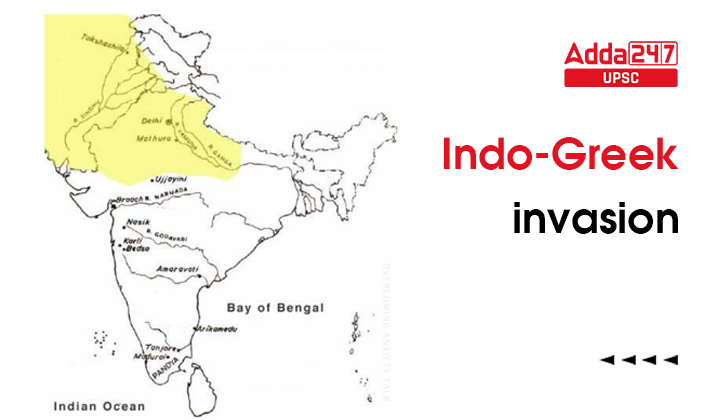Table of Contents
Indo-Greek Rule- The Indo-Greek Kingdom, also known as the Greco-Indian Kingdom, was a Hellenistic kingdom that existed in ancient India from around 180 BCE to 10 CE. The kingdom was founded by Bactrian Greeks, who migrated from the areas now known as Afghanistan and Uzbekistan.
The Indo-Greek rulers were famous for their coinage, art, and architecture, which reflected a blend of Greek and Indian styles. This article aims to explore the Indo-Greek rule in India, including its history, ideology, and decline.
The Rise of the Indo-Greek Kingdom
The Indo-Greek Kingdom emerged as a result of the collapse of the Mauryan Empire in India. The first Indo-Greek ruler was Demetrius I, who invaded northwestern India in 180 BCE. Demetrius I was followed by a series of Indo-Greek rulers, including Menander I, who is regarded as the greatest of all Indo-Greek kings.
Menander I (165 BCE- 145 BCE)
Menander I, also known as Milinda, was the most famous of all the Indo-Greek rulers. He was a patron of Buddhism and was known for his efforts to spread the religion in India. Menander I is also remembered for his coinage, which was the finest and most sophisticated of all the Indo-Greek rulers. His coins depict Buddhist symbols, such as the wheel and the lotus, as well as Greek gods and goddesses.
The Indo-Greek Kingdom Ideology
The Indo-Greek Kingdom was a blend of Greek and Indian cultures, which is reflected in their art, architecture, and coinage. The Indo-Greek rulers adopted Indian religious practices, such as Buddhism and Hinduism, and their art and architecture featured a mix of Greek and Indian styles. The Indo-Greek coinage was also a reflection of this cultural fusion, with coins featuring both Greek and Indian motifs.
Indo-Greek Coins
Indo-Greek coins were a series of coins issued by the Indo-Greek kings who ruled parts of present-day Afghanistan, Pakistan, and northwestern India between the 2nd century BCE and 1st century CE. Here are some key points about Indo-Greek coins:
- Indo-Greek coins were influenced by the Greek and Roman coinage systems and typically featured the image of the ruling king on the obverse and various gods, goddesses, and symbols on the reverse.
- The Indo-Greek kings issued gold, silver, and copper coins. Gold coins were the most valuable and were used for large transactions, while copper coins were used for smaller transactions.
- The Greek and Roman influence are evident in the use of Greek and Kharosthi scripts on the coins, as well as in the depiction of Greek gods and goddesses such as Zeus, Apollo, and Athena.
- The coins provide valuable insight into the culture, religion, and political system of the Indo-Greek kingdom. For example, some coins depict the king performing Hindu rituals or wearing a helmet with a Buddhist symbol.
- Indo-Greek coins were widely circulated in the ancient world and have been found as far as the eastern Mediterranean, suggesting that the Indo-Greek kingdom had extensive trade and diplomatic relations with neighboring regions.
- The decline of the Indo-Greek kingdom in the 1st century CE led to the cessation of coin production, and the coins gradually disappeared from circulation.
- However, the legacy of the Indo-Greek coinage system continued to influence the coinage of later dynasties in the region.
Also Read:-
| UPSC Exam-Related Study Notes | |
| Mauryan Empire |
Chola Dynasty |
| Anglo-Maratha War | 16 Mahajanapadas |
Greek presence in the Indian subcontinent
- The Greek presence in the Indian subcontinent began with the invasion of Alexander the Great in 327 BCE.
- Alexander’s conquests did not result in the establishment of a permanent Greek presence in the region, but they did pave the way for later Greek expeditions and colonization.
- The first Greek colony in the region was established by the Seleucid king, Seleucus I Nicator, who conquered parts of northwestern India and Pakistan in the late 4th century BCE.
- Seleucus exchanged territories in Afghanistan and the Indus Valley with the Indian emperor, Chandragupta Maurya, in a peace treaty that established a long-lasting alliance between the two powers.
- The Indo-Greek kingdom emerged in the aftermath of the Mauryan Empire, with Greek rulers establishing their rule in parts of present-day Afghanistan, Pakistan, and northwestern India from the 2nd century BCE to the 1st century CE.
- The Indo-Greek kings adopted elements of Indian culture and religion, such as Buddhism and Hinduism, while also maintaining their Greek heritage.
- The Indo-Greek kingdom was eventually conquered by the Indo-Scythians in the 1st century CE, leading to the decline of Greek influence in the region.
- The Greek presence in the Indian subcontinent had a significant impact on the region, influencing art, culture, religion, and language.
- The legacy of the Greek presence can still be seen in the numerous archaeological sites, sculptures, and inscriptions that have been discovered in the region.
Decline of Indo-Greek Kingdom
The Indo-Greek Kingdom, which existed in ancient times from approximately the 2nd century BCE to the 1st century CE, gradually declined due to a combination of factors.
One significant factor was the constant wars and conflicts with neighboring kingdoms and tribes, which put a strain on the Indo-Greek military and resources. This resulted in weakened defense capabilities and an inability to maintain control over territories they had conquered.
Another factor was the economic strain caused by the extensive trade and commerce that the Indo-Greek Kingdom relied upon. As trade routes shifted and new competitors emerged, the Indo-Greek economy struggled to keep up and maintain its prosperity.
In addition, there were internal conflicts and power struggles within the Indo-Greek Kingdom, which weakened the stability and cohesion of the ruling elite. This allowed external forces to take advantage of the weakened state of the kingdom and gradually conquer its territories.
Ultimately, the decline of the Indo-Greek Kingdom was a gradual and complex process, caused by a combination of internal and external factors.
Indo-Greek Rule facts for UPSC Aspirants
- The Indo-Greek Kingdom was established in the 2nd century BCE by the invasion of Alexander the Great’s successor, Seleucus I Nicator, into northern India.
- The Indo-Greek rulers were Greeks who had settled in the northwestern part of India and intermarried with the local population.
- The Indo-Greek Kingdom covered an area that included present-day Afghanistan, Pakistan, and parts of northern India.
- The Indo-Greek rulers were known for their coinage, which was influenced by both Greek and Indian styles.
- The Indo-Greek Kingdom was characterized by a fusion of Greek and Indian cultures, which resulted in a unique blend of art, architecture, and language.
- The Indo-Greek rulers were patrons of Buddhism and helped spread the religion throughout the region.
- The Indo-Greek Kingdom gradually declined due to a combination of factors, including constant wars and conflicts with neighboring kingdoms, economic strain, and internal conflicts.
- The Indo-Greek Kingdom was eventually conquered by the Kushan Empire in the 1st century CE.
- The Indo-Greek rule left a significant impact on the history and culture of northern India and influenced the development of subsequent kingdoms and empires in the region.



 TSPSC Group 1 Question Paper 2024, Downl...
TSPSC Group 1 Question Paper 2024, Downl...
 TSPSC Group 1 Answer key 2024 Out, Downl...
TSPSC Group 1 Answer key 2024 Out, Downl...
 UPSC Prelims 2024 Question Paper, Downlo...
UPSC Prelims 2024 Question Paper, Downlo...





